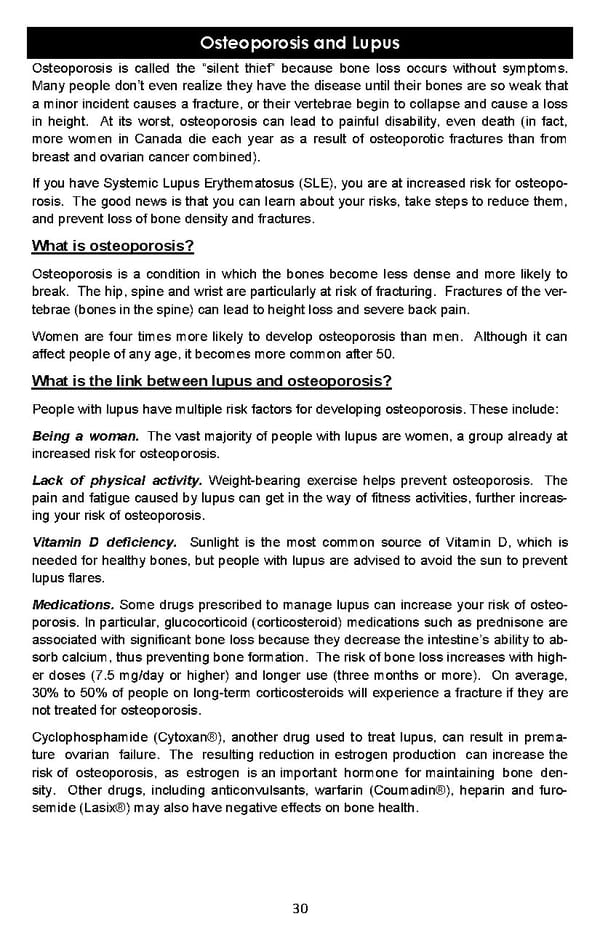Osteoporosis and Lupus Osteoporosis is called the “silent thief” because bone loss occurs without symptoms. Many people don’t even realize they have the disease until their bones are so weak that a minor incident causes a fracture, or their vertebrae begin to collapse and cause a loss in height. At its worst, osteoporosis can lead to painful disability, even death (in fact, more women in Canada die each year as a result of osteoporotic fractures than from breast and ovarian cancer combined). If you have Systemic Lupus Erythematosus (SLE), you are at increased risk for osteopo- rosis. The good news is that you can learn about your risks, take steps to reduce them, and prevent loss of bone density and fractures. What is osteoporosis? Osteoporosis is a condition in which the bones become less dense and more likely to break. The hip, spine and wrist are particularly at risk of fracturing. Fractures of the ver- tebrae (bones in the spine) can lead to height loss and severe back pain. Women are four times more likely to develop osteoporosis than men. Although it can affect people of any age, it becomes more common after 50. What is the link between lupus and osteoporosis? People with lupus have multiple risk factors for developing osteoporosis. These include: Being a woman. The vast majority of people with lupus are women, a group already at increased risk for osteoporosis. Lack of physical activity. Weight-bearing exercise helps prevent osteoporosis. The pain and fatigue caused by lupus can get in the way of fitness activities, further increas- ing your risk of osteoporosis. Vitamin D deficiency. Sunlight is the most common source of Vitamin D, which is needed for healthy bones, but people with lupus are advised to avoid the sun to prevent lupus flares. Medications. Some drugs prescribed to manage lupus can increase your risk of osteo- porosis. In particular, glucocorticoid (corticosteroid) medications such as prednisone are associated with significant bone loss because they decrease the intestine’s ability to ab- sorb calcium, thus preventing bone formation. The risk of bone loss increases with high- er doses (7.5 mg/day or higher) and longer use (three months or more). On average, 30% to 50% of people on long-term corticosteroids will experience a fracture if they are not treated for osteoporosis. Cyclophosphamide (Cytoxan®), another drug used to treat lupus, can result in prema- ture ovarian failure. The resulting reduction in estrogen production can increase the risk of osteoporosis, as estrogen is an important hormone for maintaining bone den- sity. Other drugs, including anticonvulsants, warfarin (Coumadin®), heparin and furo- semide (Lasix®) may also have negative effects on bone health. 30
 Living Well With Lupus Facts Booklet Page 29 Page 31
Living Well With Lupus Facts Booklet Page 29 Page 31